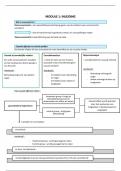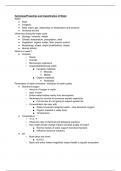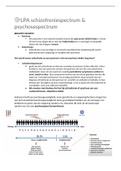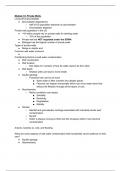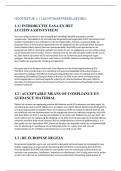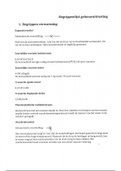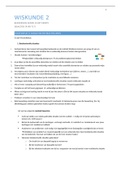BIODIVERSITY Sampling plants – random
1) Point quadrat (pins placed along bar)
Biodiversity 2) Frame quadrat (species in each square recorded)
- Species interconnected + need balanced ecosystem
- Provides food, oxygen, materials Measure
- Diverse = stable, affected by harsh conditions 1) Density – count number (absolute measure)
- Low biodiversity = stressful/extreme environment, 2) Frequency – 65/100 squares so 65% occur (ACFOR)
specific adaptations, simple food web 3) Percentage cover – area cover, difficult to count
4) Capture and release – mark animals and let the
Habitat biodiversity – different habitats in an area redistribute, ↑ marked ones recaptured, ↓ the pop
Different scales, ↑ habitat bio = ↑ species bio
Calculating biodiversity
Species biodiversity - species richness = no of species, Simpson’s index of diversity
species evenness = how spread-out individuals are > Between 0-1 (1 = high diversity)
Genetic biodiversity – variety of alleles (breeds) show diff
characteristics, better adapted to environ change
Increase genetic biodiversity – mutation, interbreeding
Decreasing genetic biodiversity
- Selective breeding (favoured characteristic)
- Captive breeding Genetic biodiv = measure proportion of heterozygotes
- Artificial cloning (asexual reproduction) > Polymorphic gene = more than one allele
- Natural selection – less advantageous die out > Monomorphic gen = single allele for one gene
- Genetic bottlenecks (few individuals survive)
- The founder effect – form new isolated colony
- Genetic drift – independent assortment
Sampling
Random sampling = chance Factors affecting biodiversity
1) Mark out grid using tape measures (right angle) Deforestation
2) Random number generator for coordinates - Destroys habitat + food source, ↓ species diversity
- Animals forced to migrate
Non random sampling
1) Opportunistic – convenient, not representative Agriculture
2) Stratified – divide groups, proportional sample each - Few different crops, selected for high yield
3) Systematic – line / belt transects - Monoculture – supports few animals
- Deforestation – clear the land
Reliability - Hedgerow removal – destroys habitats
> Sampling bias – picking area - Kill weeds – affect animal diversity
> Chance – not representative of whole pop - Pesticides/herbicides
> Larger sample size = reliable, mean
Climate change
Abiotic factors - Warmer air can hold extra water vapour
> Light + water availability - Sea level rise (expansion) – flood habitats + saltwater
> Rapid changes detected - Arctic – ice melt, glacier decline – shrinks habitats
> Human error reduced, very precise - Less rainfall – xerophytes
> Data stored and monitored on computer - CO2 ↑ since industrial revolution (traps heat)
- Change insect lifecycle (pollinators)
Sampling animals - If change slow, species have time to adapt/migrate
> Pooter (catch small insects)
> Sweep net Reasons for maintaining biodiversity
> Pitfall trap (roof so not flood) Aesthetic
> Tree beating (animals fall onto white sheet) - Erich lives (relaxation)
> Kick sampling (net held under water in river) - Provides inspiration for artists
> Quadrats for slow moving animals - Patients recover quickly from stress/injury
1) Point quadrat (pins placed along bar)
Biodiversity 2) Frame quadrat (species in each square recorded)
- Species interconnected + need balanced ecosystem
- Provides food, oxygen, materials Measure
- Diverse = stable, affected by harsh conditions 1) Density – count number (absolute measure)
- Low biodiversity = stressful/extreme environment, 2) Frequency – 65/100 squares so 65% occur (ACFOR)
specific adaptations, simple food web 3) Percentage cover – area cover, difficult to count
4) Capture and release – mark animals and let the
Habitat biodiversity – different habitats in an area redistribute, ↑ marked ones recaptured, ↓ the pop
Different scales, ↑ habitat bio = ↑ species bio
Calculating biodiversity
Species biodiversity - species richness = no of species, Simpson’s index of diversity
species evenness = how spread-out individuals are > Between 0-1 (1 = high diversity)
Genetic biodiversity – variety of alleles (breeds) show diff
characteristics, better adapted to environ change
Increase genetic biodiversity – mutation, interbreeding
Decreasing genetic biodiversity
- Selective breeding (favoured characteristic)
- Captive breeding Genetic biodiv = measure proportion of heterozygotes
- Artificial cloning (asexual reproduction) > Polymorphic gene = more than one allele
- Natural selection – less advantageous die out > Monomorphic gen = single allele for one gene
- Genetic bottlenecks (few individuals survive)
- The founder effect – form new isolated colony
- Genetic drift – independent assortment
Sampling
Random sampling = chance Factors affecting biodiversity
1) Mark out grid using tape measures (right angle) Deforestation
2) Random number generator for coordinates - Destroys habitat + food source, ↓ species diversity
- Animals forced to migrate
Non random sampling
1) Opportunistic – convenient, not representative Agriculture
2) Stratified – divide groups, proportional sample each - Few different crops, selected for high yield
3) Systematic – line / belt transects - Monoculture – supports few animals
- Deforestation – clear the land
Reliability - Hedgerow removal – destroys habitats
> Sampling bias – picking area - Kill weeds – affect animal diversity
> Chance – not representative of whole pop - Pesticides/herbicides
> Larger sample size = reliable, mean
Climate change
Abiotic factors - Warmer air can hold extra water vapour
> Light + water availability - Sea level rise (expansion) – flood habitats + saltwater
> Rapid changes detected - Arctic – ice melt, glacier decline – shrinks habitats
> Human error reduced, very precise - Less rainfall – xerophytes
> Data stored and monitored on computer - CO2 ↑ since industrial revolution (traps heat)
- Change insect lifecycle (pollinators)
Sampling animals - If change slow, species have time to adapt/migrate
> Pooter (catch small insects)
> Sweep net Reasons for maintaining biodiversity
> Pitfall trap (roof so not flood) Aesthetic
> Tree beating (animals fall onto white sheet) - Erich lives (relaxation)
> Kick sampling (net held under water in river) - Provides inspiration for artists
> Quadrats for slow moving animals - Patients recover quickly from stress/injury

